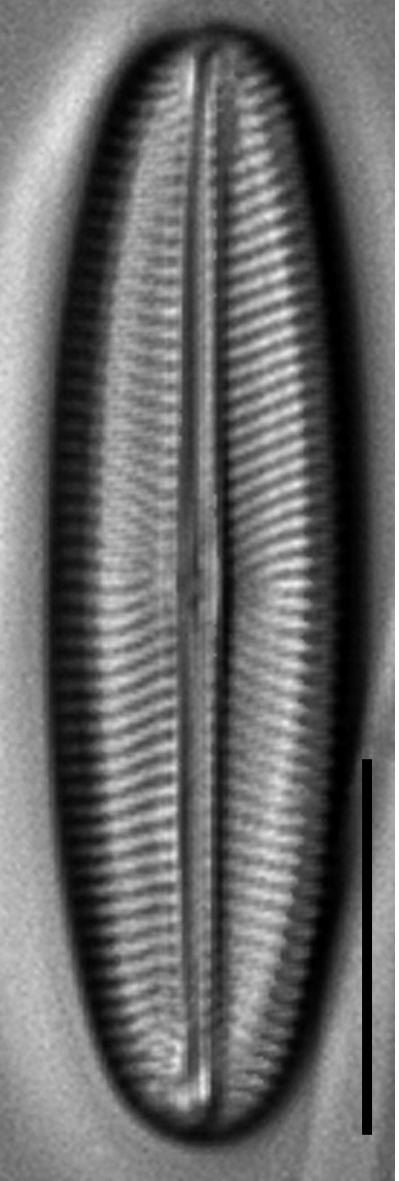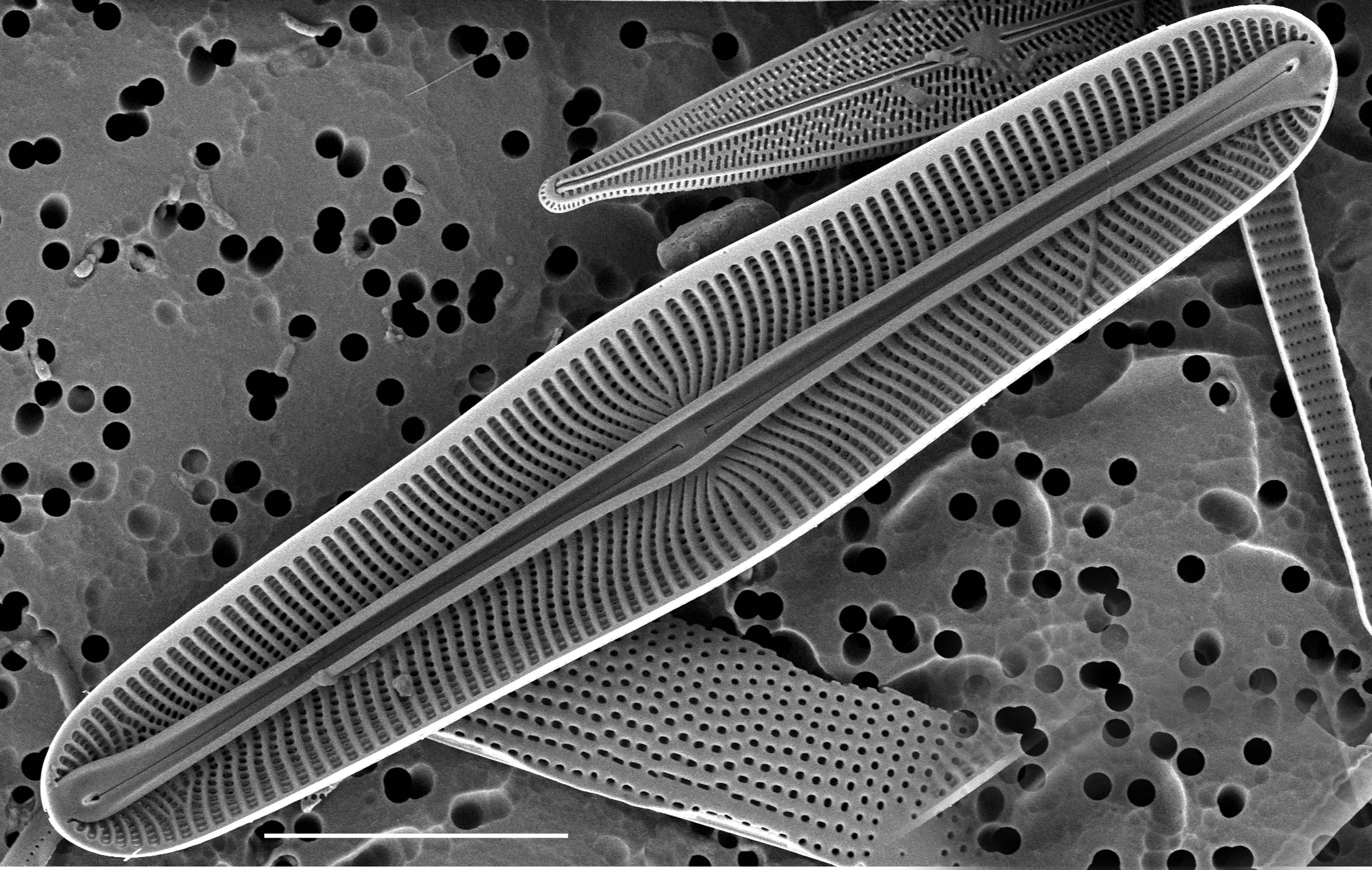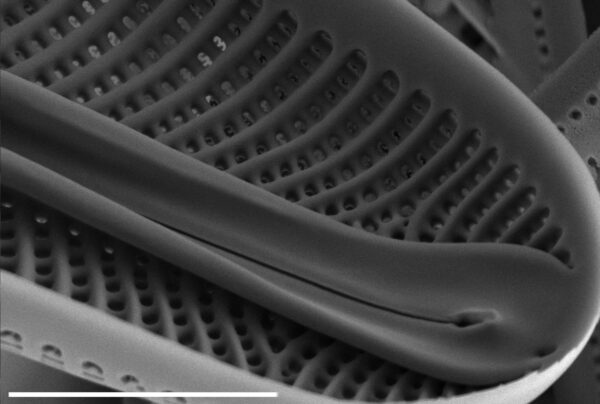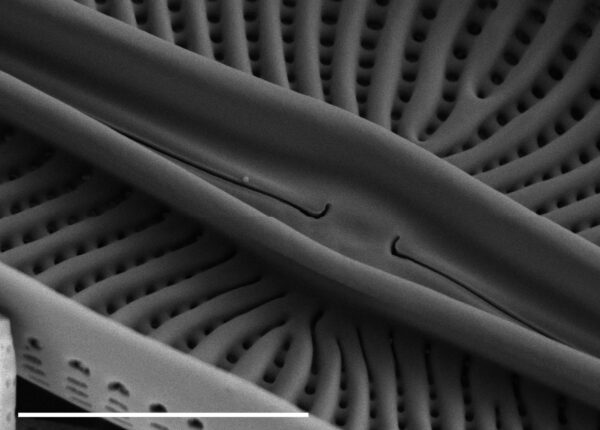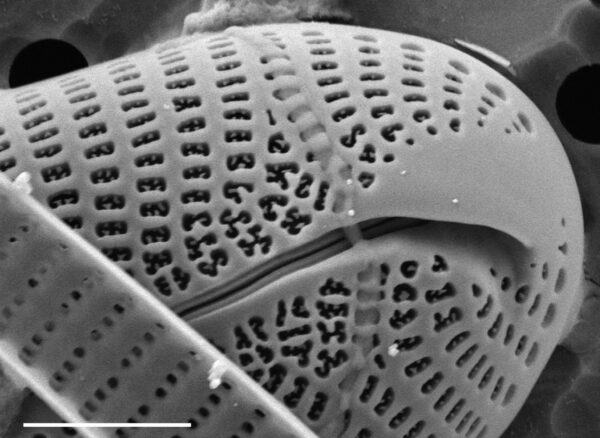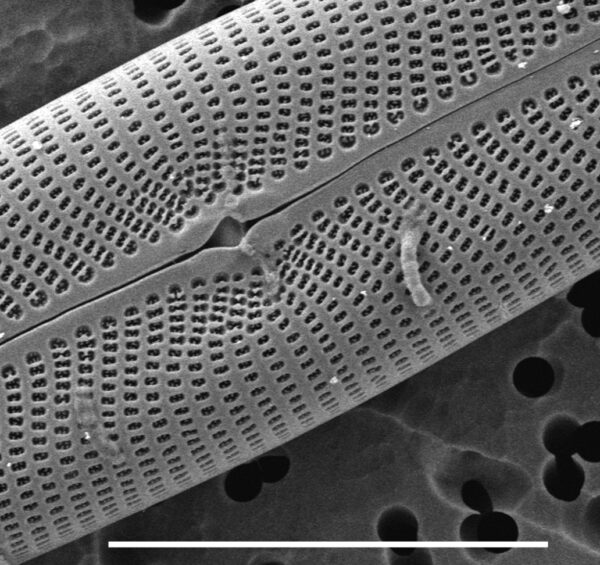Envekadea metzeltinii
-
Category
-
Length Range31-70 µm
-
Width Range8-11 µm
-
Striae in 10 µm18-19
-
Reported AsNavicula palestinae (Hein et al. 2008, pg. 76, Fig. 50.5)
-
ContributorSylvia Lee, Bart Van de Vijver - May 2013
-
ReviewerSarah Spaulding - Sep 2013
Identification
Description
Valves are linear with almost parallel margins. The central part of the valve is gibbous in larger specimens and slightly convex in smaller valves. The axial area is narrow, less than 1/9 of the total valve width, linear and widens very slightly near the central area. The external central area is highly reduced. Internally, two distinct longitudinal ribs (also termed axial costae) border the axial area. The longitudinal ribs widen slightly at the central area of the valve. Near the apices, the longitudinal ribs diverge, forming a plate-like, rounded, hyaline zone, revealing the sigmoid course of the raphe.
The external raphe branches are positioned in a deep, narrow groove that is straight to very weakly undulate. The proximal raphe ends are straight and terminate in a depression, bordered by four slightly raised plates. Inside the depression, a raised central nodule is visible on which the proximal ends terminate. The external distal raphe ends terminate in opposite directions and the raphe is sigmoid. The raphe diverges from the sigmoid external groove, and follows a straight course. The internal raphe branches are situated on a sternum between longitudinal ribs that extend from apex to apex. Internally, the proximal raphe ends are hooked and the distal raphe ends terminate in short, simple helictoglossae.
Striae are clearly radiate, slightly geniculate and equidistant throughout the entire valve. In the central area, several irregularly shortened striae are inserted in the normal striation pattern. Near the apices, a sudden shift in stria orientation is present. Several very short striae are inserted near the axial area. Striae are uniseriate and composed of areolae that are variable in size and shape. Taxa within the genus are reported to have external hymenes covering the areolae (Gligora et al. 2009), but were never observed in E. metzeltinii due to rarity of valves in our collections and the severe oxidizing treatment used for LM and SEM. Most areolae are apically elongated and rectangular. Near the central area and the apices, areolae are very irregular in shape, with a higher stria density than the rest of the valve. Short hymenes (perhaps degraded by cleaning methods) are visible by SEM inside the areolae. A hyaline zone separating the striae is present at the apices, delimited by the external distal raphe ends. Striae continue uninterrupted onto the mantle. A narrow hyaline zone is present near the mantle edge. Internally, striae are located between clearly raised virgae and composed of rounded, unoccluded areolae. Near the central area, striae diminish in width toward the axial area.
Due to the rarity of this taxon in our samples, no frustules in girdle view have been observed. This has also been found in the Yucatan region of Mexico, where it was identified as a species of Scoliotropis (Metzeltin and Lange-Bertalot 2007).
Autecology
Envekadea metzeltinii has been found in Florida (Everglades coastal marine and brackish wetlands), Mexico (Yucatan) and the Bahamas (Hein et al. 2008). This taxon was present in low numbers (< 1% relative abundance) in a periphyton assemblage of green algae and bladderwort from a brackish marsh. The water chemistry was 3900 µS/cm conductivity, 6.5 pH, and 270 µg/g total phosphorus.
-
Size Range, µm3
-
Motility
-
Attachment
-
Habitat
-
Colony
-
Waterbody
- Learn more about this
Original Description
-
AuthorLee et al. 2013
Citations & Links
Citations
-
Publication Link: 10.1080/09670260802389783
-
Publication Link: doi:10.11646/phytotaxa.115.1.2
Links
-
Index Nominum Algarum
Cite This Page
Lee, S., van de Vijver, B. (2013). Envekadea metzeltinii. In Diatoms of North America. Retrieved April 19, 2024, from https://diatoms.org/species/envekadea_metzeltinii
Responses
The 15 response plots show an environmental variable (x axis) against the relative abundance (y axis) of Envekadea metzeltinii from all the stream reaches where it was present. Note that the relative abundance scale is the same on each plot. Explanation of each environmental variable and units are as follows:
ELEVATION = stream reach elevation (meters)
STRAHLER = distribution plot of the Strahler Stream Order
SLOPE = stream reach gradient (degrees)
W1_HALL = an index that is a measure of streamside (riparian) human activity that ranges from 0 - 10, with a value of 0 indicating of minimal disturbance to a value of 10 indicating severe disturbance.
PHSTVL = pH measured in a sealed syringe sample (pH units)
log_COND = log concentration of specific conductivity (µS/cm)
log_PTL = log concentration of total phosphorus (µg/L)
log_NO3 = log concentration of nitrate (µeq/L)
log_DOC = log concentration of dissolved organic carbon (mg/L)
log_SIO2 = log concentration of silicon (mg/L)
log_NA = log concentration of sodium (µeq/L)
log_HCO3 = log concentration of the bicarbonate ion (µeq/L)
EMBED = percent of the stream substrate that is embedded by sand and fine sediment
log_TURBIDITY = log of turbidity, a measure of cloudiness of water, in nephelometric turbidity units (NTU).
DISTOT = an index of total human disturbance in the watershed that ranges from 1 - 100, with a value of 0 indicating of minimal disturbance to a value of 100 indicating severe disturbance.
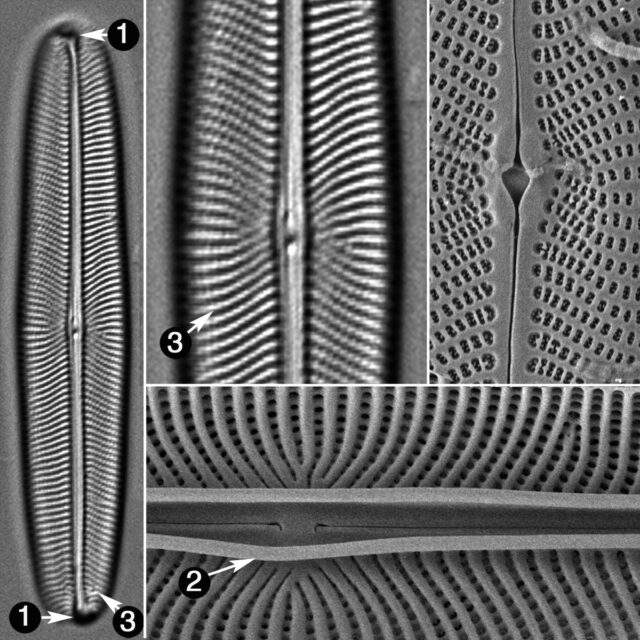
Envekadea metzeltinii
- Distal raphe ends deflected to opposite sides
- Longitudinal ribs present
- Striae radiate, except at apices
Valves are linear, with nearly parallel margins. Internal, longitudinal ribs are present. The raphe is straight, except at the apices where the distal raphe ends are hooked to opposite sides. The proximal raphe ends are small and straight. Striae are radiate and weakly bent, except at the apices, where the striae are divergent.
 Diatoms of North America
Diatoms of North America



